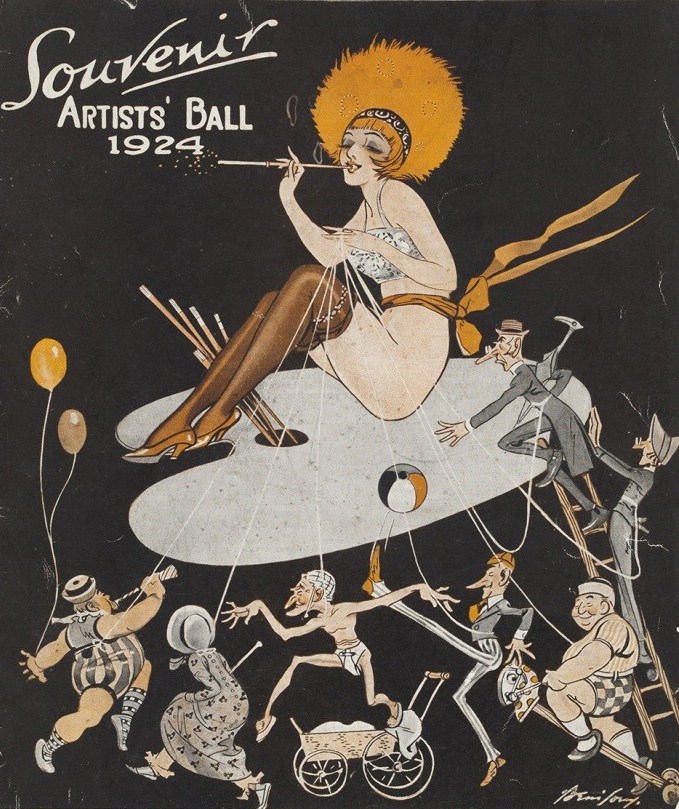Staying in my hometown for a moment longer, where the spirits of bohemia will stir from their paupers’ graves this weekend…
Sydney’s Artists’ Ball had its origins in the 1880s, but reached its peak in the 1920s. Like the Bal des Quat’z Arts in Paris, London’s Chelsea Arts Club Ball and Munich’s Fasching revels, it was an annual opportunity for the city’s artists, writers and non-aligned bohemians to pool their meagre resources for one spectacular, costumed bacchanal. Dancing with Empty Pockets, Tony Moore’s book about Australia’s overlooked bohemian experience (which a reader kindly alerted me to), sets the scene:
The Artists’ Balls of Sydney’s ‘Roaring Twenties’ were the climax of a half-century long Australian bohemian carnival. But this ball was different, signalling the start of a decade of revelry in the harbour city. The ball had ceased during the war, but was spectacularly relaunched in 1922, with a modern makeover. Partygoers danced the Charleston to a jazz band, symbolic of the unstoppable global ascendancy of American popular culture with its dance crazes, Tin Pan Alley songs, Hollywood movies and comic books.
The next year’s ball was even more daring. Romance writer and journalist Dulcie Deamer acquired instant notoriety by wearing a skimpy leopard-skin dress and a dog-tooth necklace, and was crowned ‘Queen of Bohemia’. The First World War had loosened many nineteenth-century restrictions on women and some, like the talented and feisty Dulcie, were welcomed as journalists and into the heart of bohemia. She likened the end of war to an ‘out of school’ feeling and the bohemian balls of the twenties to ‘a sunburst announcing a joie de vivre‘.
Like Sydney’s Gay and Lesbian Mardi Gras at the end of the twentieth century, the Artists’ Balls were a steamy stage on which to exhibit new freedoms in sexuality and the body. Joan Lindsay, wife of Norman’s son Ray, relished the fact that ‘they were really sort of orgies I think, everyone was sick all over the place’. She also remembered that the ball was a safe haven where homosexual men, many of whom worked in design, acting and fashion, could dress in ‘drag’ and avoid legal and moral repercussions. One newsreel story from the period, ‘Bohemia’s night out’, highlighted the drunken, stumbling dancing as much as the imaginative costumes. Sex was joined by alcohol-fuelled violence at the 1924 ball, with police raiding the party and eleven casualties leaving by ambulance; there was a point at which the state’s tolerance of bohemian revelry was withdrawn. Although the police presence increased after that debacle, Dulcie Deamer could happily report that by the 1927 party ‘a glittering flood was threatening the dike that dammed it, and those in uniform…lost the battle. The gods of Spring – it was September – and Carnival were against them.’
Once the heedless 1920s gave way to the straitened 1930s, the ball found quarters in the upscale David Jones department store and was respectable enough for vice-regal patronage. The 1933 ball, which was indeed graced by the presence of the whimsically named Governor General Isaac Isaacs, is now being recreated in the same venue. Rather wonderfully, it will be attended by one of the original 1930s revellers, who first made it to the Artists’ Ball in 1936, when it was held within the forbidding sandstone walls of the colonial-era Darlinghurst Gaol (yes, again ‘clouds!). Gwenna Thatcher, the 96-year-old reveller in question, is looking forward to the ball this Saturday, while adding that “when you get to my age, anything is exciting.”
Holding the event in the city’s most expensive department store may be historically accurate, but charging 125 Australian dollars’ entry is clearly a clever conceptual commentary on the appropriation of bohemian culture by the forces of consumerism. This, in a city where stratospheric rents dictate that “bar culture” means 20 dollar cocktails and midnight curfews, inner city artists’ studios have been replaced by pop-up artisanal banh mi shops and the gay scene is a shadow of its former hedonistic self – offline at least. And this, on the day of Australia’s federal elections when – barring a miracle – the philistine, arch-materialist, fear-mongering, mean-minded, centre-right Liberal Party will be voted into power. At least Sydney’s champagne socialists will have somewhere to drown their sorrows.






Please don’t rub it in. I’m at the end of my tether here.
Belated commiserations…
I fully expect Darlinghurst Gaol to be a stop on the Strange Flowers package tour of the world. And as our guide, I hope you’ll consider wearing a wagon wheel hat and a gift wrap bow in your hair, Dulcie style (see fourth photo here), so that we won’t lose you in a crowd of art students/chicken hawks/ghosts of inmates past.
We shall be travelling overland on the multi-storey crystal bus designed by Oliver Messel for Edward James, then embarking on a recreation of Joe Carstairs’ Estelle. It will take months, and it will be *divoon*.
You should also keep an eye out for the wonderful “The Sea Coast of Bohemia”, Peter Kirpatrick’s wonderful 1992 book about Sydney literary life in the 1920s. It was published by University of Qld Press.
Thanks for the tip!
Pingback: Secret Satan, 2019 | Strange Flowers